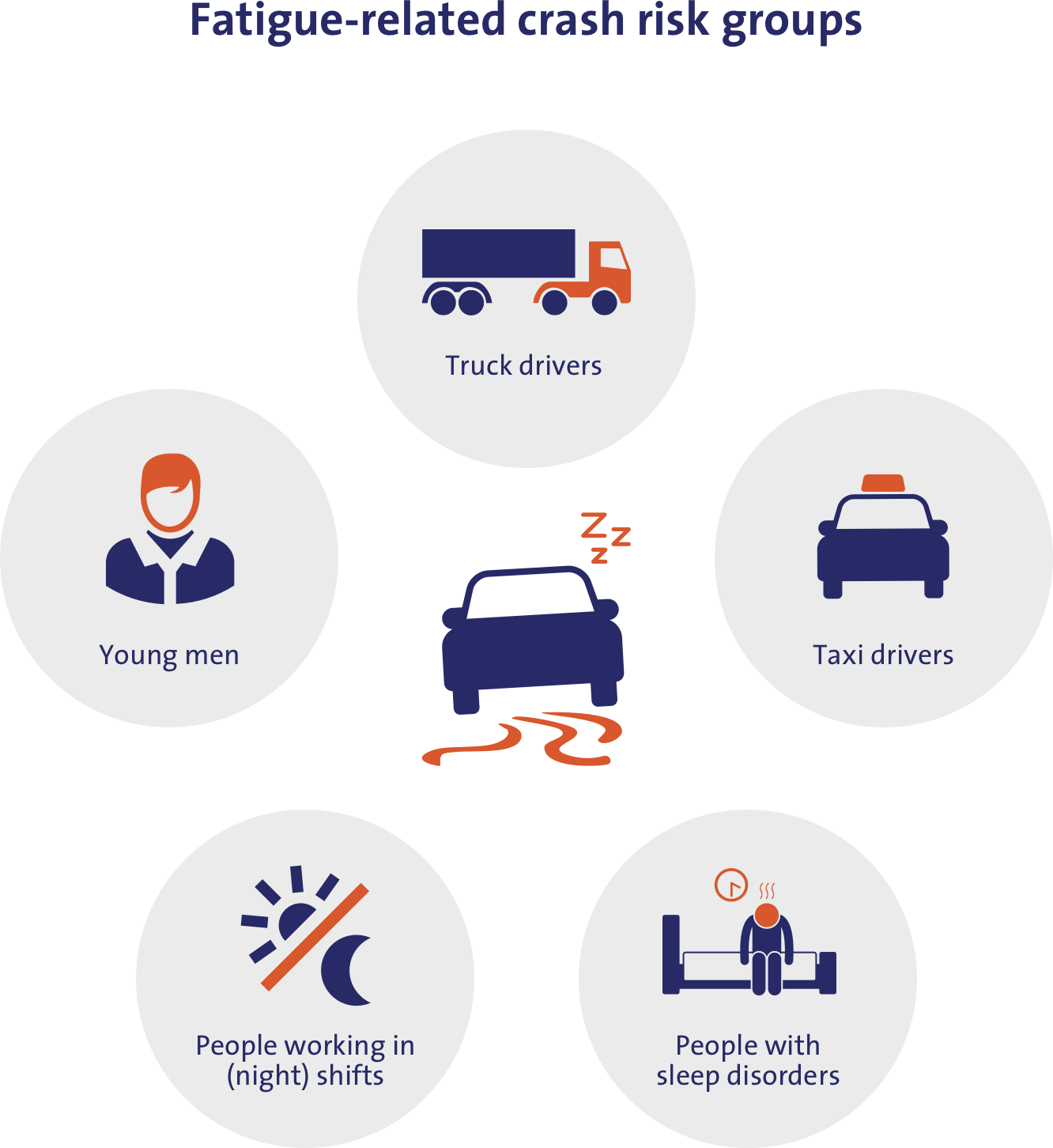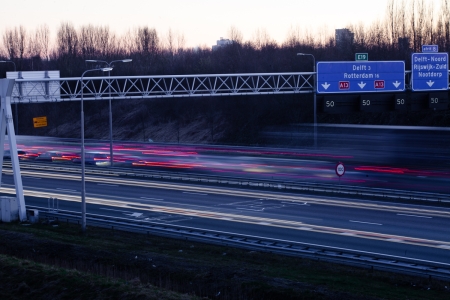Below you will find the list of references that are used in this fact sheet. All sources used can be consulted or retrieved via our Library portal. Here you can also find more literature on this subject.
[1]. May, J.F. & Baldwin, C.L. (2009). Driver fatigue: The importance of identifying causal factors of fatigue when considering detection and countermeasure technologies. In: Transportation Research Part F, vol. 12, p. 218-224.
[2]. Schagen, I. van (2003). Vermoeidheid achter het stuur. Een inventarisatie van oorzaken, gevolgen en maatregelen [Fatigue while driving; Inventory of causes, effects and measures] [Fatigue while driving; Inventory of causes, effects and measures]. R-2003-16 [Summary in English]. SWOV, Leidschendam.
[3]. European Commission (2018). Fatigue 2018. European Commission, Directorate General for Transport.
[4]. Phillips, R.O. (2014). What is fatigue and how does it affect the safety performance of human transport operators? TØI report 1351/2014. Institute of Transport Economics (TØI), Oslo.
[5]. Brown, I.D. (1994). Driver Fatigue. In: Human Factors, vol. 36, nr. 2, p. 298-314.
[6]. Gastaldi, M., Rossi, R. & Gecchele, G. (2014). Effects of Driver Task-related Fatigue on Driving Performancev. In: Procedia - Social and Behavioral Sciences, vol. 111, p. 955-964.
[7]. Filtness, A.J. & Beanland, V. (2018). Sleep loss and change detection in driving scenes. In: Transportation Research Part F: Traffic Psychology and Behaviour, vol. 57, p. 10-22.
[8]. Zhang, H., Wu, C., Yan, X. & Qiu, T.Z. (2016). The effect of fatigue driving on car following behaviorv. In: Transportation Research Part F: Traffic Psychology and Behaviour, vol. 43, p. 80-89.
[9]. Goldenbeld, C., Davidse, R.J., Mesken, J. & Hoekstra, A.T.G. (2011). Vermoeidheid in het verkeer: Prevalentie en statusonderkenning bij automobilisten en vrachtautochauffeurs; Een vragenlijststudie onder Nederlandse rijbewijsbezitters [Driver fatigue: prevalence and state awareness of drivers of passenger cars and trucks. A questionnaire study among driving licence holders in the Netherlands]. R-2011-4 [Summary in English]. SWOV, Leidschendam.
[10]. Williamson, A., Friswell, R., Olivier, J. & Grzebieta, R. (2014). Are drivers aware of sleepiness and increasing crash risk while driving? In: Accident Analysis & Prevention, vol. 70, p. 225-234.
[11]. Lim, S.M. & Chia, S.E. (2015). The prevalence of fatigue and associated health and safety risk factors among taxi drivers in Singapore. In: Singapore medical journal, vol. 56, nr. 2, p. 92-97.
[12]. Horne, J. & Reyner, L. (2001). Sleep-related vehicle accidents: some guides for road safety policiesv. In: Transportation Research Part F: Traffic Psychology and Behaviour, vol. 4, nr. 1, p. 63-74.
[13]. Moradi, A., Nazari, S.S.H. & Rahmani, K. (2018). Sleepiness and the risk of road traffic accidents: A systematic review and meta-analysis of previous studies. In: Transportation Research Part F: Traffic Psychology and Behaviour.
[14]. ETSC (2001). The role of driver fatigue in commercial road transport crashes. European Transport Safety Council, Brussel.
[15]. Dawson, D., Reynolds, A.C., Dongen, H.P.A. van & Thomas, M.J.W. (2018). Determining the likelihood that fatigue was present in a road accident: A theoretical review and suggested accident taxonomy. In: Sleep Medicine Reviews, vol. 42, p. 202-210.
[16]. McKernon, S. (2008). Driver fatigue literature review. Research Report 342. Land Transport New Zealand, Wellington.
[17]. Talbot, R. & Filtness, A. (2017). Fatigue – Not enough sleep/Driving while tired. European Road Safety Decision Support System, developed by the H2020 project SafetyCube. Accessed on 09-04-2019 at www.roadsafety-dss.eu.
[18]. Zhang, T. & Chan, A.H.S. (2014). Sleepiness and the risk of road accidents for professional drivers: A systematic review and meta-analysis of retrospective studies. In: Safety Science, vol. 70, p. 180-188.
[19]. Fletcher, A. & Mitchell, P. (2011). Fatigue-related risks for Queensland taxi drivers. Queensland Government, Australia.
[20]. Meng, F., Li, S., Cao, L., Li, M., et al. (2015). Driving fatigue in professional drivers: a survey of truck and taxi drivers. In: Traffic Injury Prevention, vol. 16, nr. 5, p. 474-483.
[21]. Smolensky, M.H., Di Milia, L., Ohayon, M.M. & Philip, P. (2011). Sleep disorders, medical conditions, and road accident risk. In: Accident Analysis & Prevention, vol. 43, nr. 2, p. 533-548.
[22]. Sieber, W.K., Robinson, C.F., Birdsey, J., Chen, G.X., et al. (2014). Obesity and other risk factors: The national survey of U.S. long-haul truck driver health and injury. In: American Journal of Industrial Medicine, vol. 57, nr. 6, p. 615-626.
[23]. NHG (2014). Standaard slaapproblemen en slaapmiddelen. Nederlands Huisartsen Genootschap. Accessed on 21-05-2019 at https://www.nhg.org/standaarden/volledig/nhg-standaard-slaapproblemen-en-slaapmiddelen#idp9695936.
[24]. Wiegand, D.M., Hanowski, R.J. & McDonald, S.E. (2009). Commercial drivers' health: A naturalistic study of body mass index, fatigue, and involvement in safety-critical events. In: Traffic Injury Prevention, vol. 10, nr. 6, p. 573-579.
[25]. Ridder, R. de & Bhagwant, A. (2018). Klok verzetten naar de wintertijd: wat doet het met je? Dokterdokter; Solvo. Accessed on 09-05-2019 at https://www.dokterdokter.nl/gezond-leven/psyche/klok-verzetten-naar-wintertijd-wat-doet-het/item28893.
[26]. Westland, E. (2017). Feit of fabel: Dit zijn de gevolgen van wintertijd op je biologische ritme. Nu.nl. Accessed on 09-05-2019 at https://www.nu.nl/weekend/4980548/feit-of-fabel-gevolgen-van-wintertijd-biologische-ritme.html.
[27]. Bijleveld, F.D. & Stipdonk, H.L. (2013). De relatie tussen het ingaan van de wintertijd en het aantal verkeersslachtoffers [The relation between the end date of daylight saving time and the number of road traffic casualties]. R-2013-8 [Summary in English]. SWOV, Leidschendam.
[28]. Ahlström, C., Anund, A., Fors, C. & Åkerstedt, T. (2018). Effects of the road environment on the development of driver sleepiness in young male drivers. In: Accident Analysis & Prevention, vol. 112, p. 127-134.
[29]. Matthews, G., Neubauer, C., Saxby, D.J., Wohleber, R.W., et al. (2019). Dangerous intersections? A review of studies of fatigue and distraction in the automated vehicle. In: Accident Analysis & Prevention, vol. 126, p. 85-94.
[30]. Goldenbeld, C. (2017). Driving hours and rest time / hours of service regulations for commercial drivers. European Road Safety Decision Support System, developed by the H2020 project SafetyCube. Accessed on 12-03-2019 at www.roadsafety-dss.eu.
[31]. Ministerie van IenW (2019). Wat is er wettelijk geregeld voor de rijtijden en rusttijden bij wegvervoer? Ministerie van Infrastructuur en Waterstaat. Accessed on 21-05-2019 at https://www.rijksoverheid.nl/onderwerpen/werktijden/vraag-en-antwoord/rijtijden-en-rusttijden-wegvervoer.
[32]. TLN (2018). 45 uur rust in cabine. Transport en Logistiek Nederland. Accessed on 21-05-2019 at https://www.tln.nl/onderwerp/45-uur-weekendrust-in-cabine.
[33]. TaxiPro (2015). Bekijk de nieuwe rij- en rusttijden voor taxichauffeurs. TaxiPro. Accessed on 21-05-2019 at https://www.taxipro.nl/geen-categorie/2015/01/02/bekijk-de-nieuwe-rij-en-rusttijden-voor-taxichauffeurs/?gdpr=accept.
[34]. Taxiregels.nl (2019). Arbeids- en rusttijden. Taxiregels.nl. Alle wet- en regelgeving voor de taxi op een rij. Accessed on 21-05-2019 at https://www.taxiregels.nl/chauffeur/zelfstandig/met-vergunning/rij-en-rusttijden#info.
[35]. Brookhuis, K., Vlakveld, W. & Kraaij, J. (2000). Vermoeidheid achter het stuur in een klein land. Adviesdienst Verkeer en Vervoer, Rotterdam.
[36]. Jettinghoff, K., Starren, A., Houtman, I. & Henstra, D. (2005). I love uitgerust achter het stuur!? Vermoeidheid in het verkeer: maatregelen in het buitenland en hun toepasbaarheid in Nederland. Twijnstra Gudde, Amersfoort.
[37]. Schagen, I. van (red.) (2003). Veiligheidscultuur in het verkeer: bijdragen aan het seminar van 12 november 2002. SWOV, Leidschendam.
[38]. Bax, C., Goldenbeld, C. & Korving, H. (2014). Veiligheidscultuur in de praktijk: motieven, uitvoering en effecten. R-2014-33. SWOV, Den Haag.
[39]. Vlakveld, W. (2019). Veiligheidseffecten van rijtaakondersteunende systemen. Bijlage bij het convenant van de ADAS Alliantie. R-2019-14. SWOV, Den Haag.
[40]. European Commission (2018). Proposal for a REGULATION OF THE EUROPEAN PARLIAMENT AND OF THE COUNCIL on type-approval requirements for motor vehicles and their trailers, and systems, components and separate technical units intended for such vehicles, as regards their general safety and the protection of vehicle occupants and vulnerable road users, amending Regulation (EU) 2018/… and repealing Regulations (EC) No 78/2009, (EC) No 79/2009 and (EC) No 661/2009. COM/2018/286 final - 2018/0145 (COD). European Commission, Brussel.
[41]. Matthews, G., Wohleber, R., Lin, J., Funke, G., et al. (2019). Monitoring Task Fatigue in Contemporary and Future Vehicles: A Review. In: Cassenti, D.N. (red.), Advances in Human Factors in Simulation and Modeling. Springer International Publishing, Cham, Switzerland, p. 101-112.


